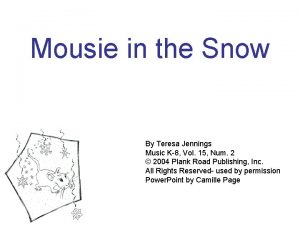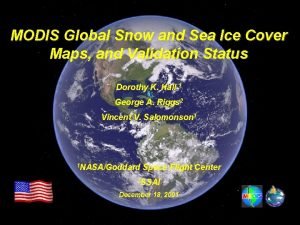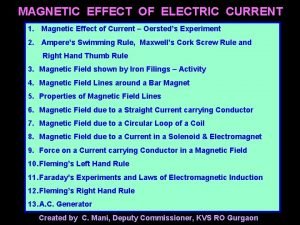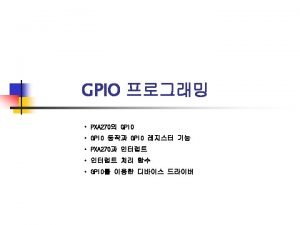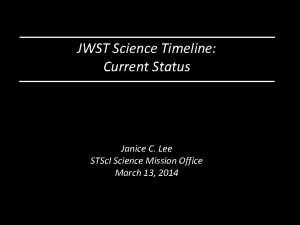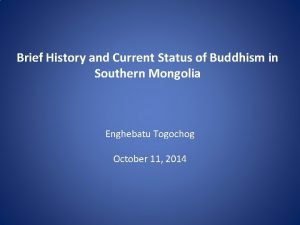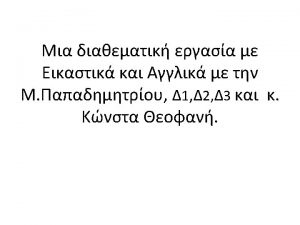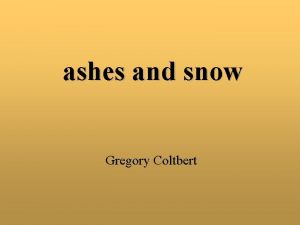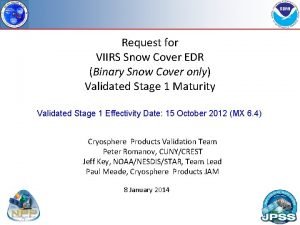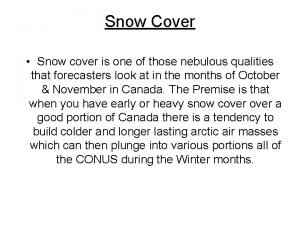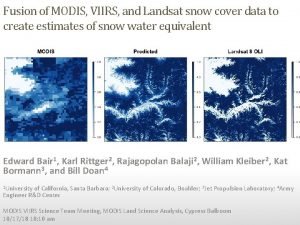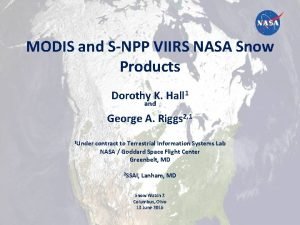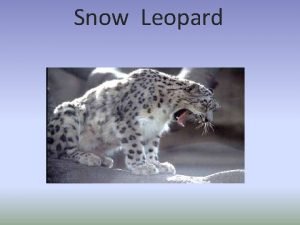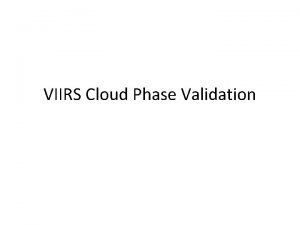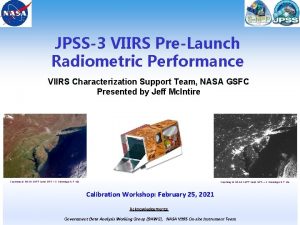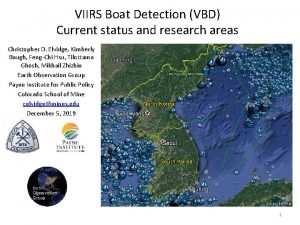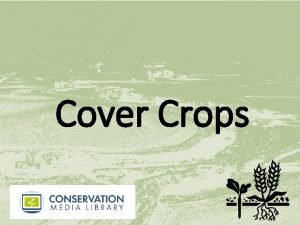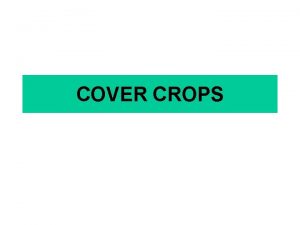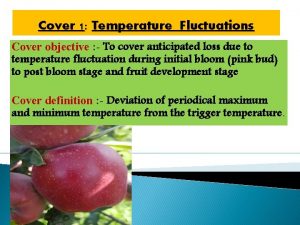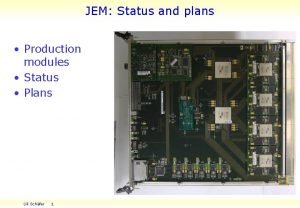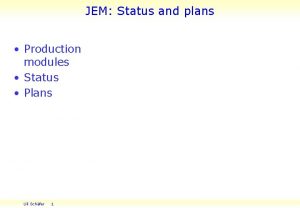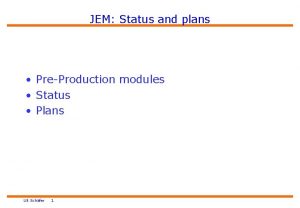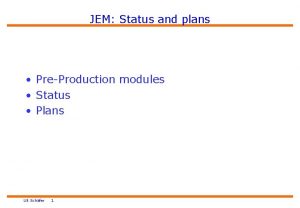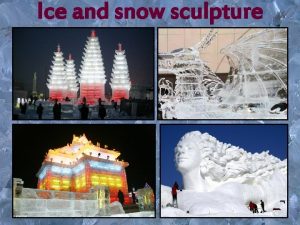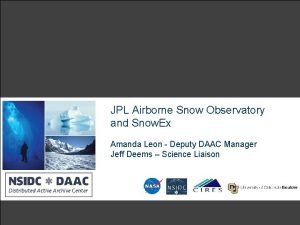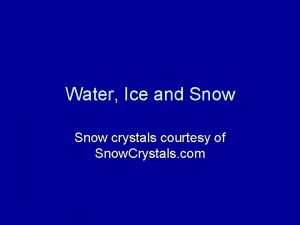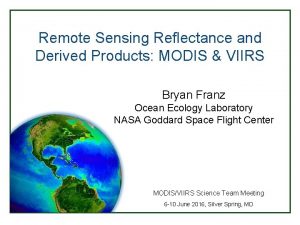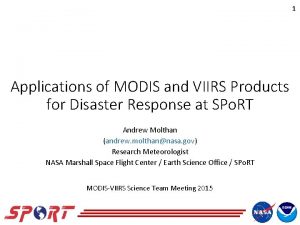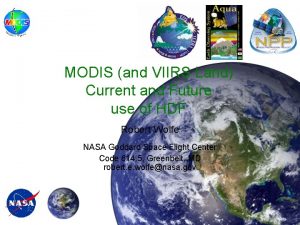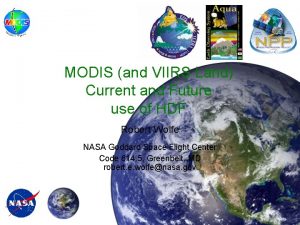VIIRS SNOW COVER PRODUCTS CURRENT STATUS AND PLANS































- Slides: 31

VIIRS SNOW COVER PRODUCTS: CURRENT STATUS AND PLANS Peter Romanov CREST/CUNY at NOAA/STAR peter. romanov@noaa. gov STAR JPSS Annual Science Team Meeting, 8 -12 August 2016 1

Outline • VIIRS Binary Snow Cover and Fractional Snow Cover – Definition, requirements – IDPS product performance – Improvements in the Enterprise system (NDE) – JPSS-1 readiness, post-launch plans – NOAA vs NASA approach – Further algorithm enhancements STAR JPSS Annual Science Team Meeting, 8 -12 August 2016 2

Cal/Val Team Members Name Organization Roles and Responsibilities Jeff Key NOAA/NESDIS Cryosphere Team Lead Peter Romanov CUNY/CREST Snow Products Lead Sean Helfrich NOAA/NIC User/Applications Michael Ek NOAA/NWS User/Applications STAR JPSS Annual Science Team Meeting, 8 -12 August 2016 3

VIIRS Snow Cover Products • Binary snow map: – Snow/no snow discrimination – 375 m resolution – 90% probability of correct typing • Over climatologically snow-affected areas • Excludes forested areas • Snow fraction: – “Viewable” snow fraction – 750 m resolution (IDPS), 375 m for JPSS-1 – 10% accuracy • Both products are clear-sky daytime-only land products • Both products depend on the accuracy of VIIRS cloud mask. STAR JPSS Annual Science Team Meeting, 8 -12 August 2016 4

Binary Snow Cover STAR JPSS Annual Science Team Meeting, 8 -12 August 2016 5

IDPS Binary Snow Cover Algorithm • Analogous to MODIS Snow. Map algorithm (Hall et. al 2002) • Decision-tree threshold-based classification approach • Uses NDSI, NDVI, reflectance, temperature (VIIRS bands I 1, I 2, I 3, I 5) NDSI = (R 0. 6μm – R 1. 6μm ) / (R 0. 6μm + R 1. 6μm) • Output: Binary snow/no-snow map at 375 m resolution MODIS Snow. Map snow acceptance region STAR JPSS Annual Science Team Meeting, 8 -12 August 2016 6

VIIRS IDPS Daily Snow Map - Daily global gridded snow maps at 1 km resolution produced since 2013 - Granules with no land pixels are not processed (shown in dark gray) - On the Web: http: //www. star. nesdis. noaa. gov/smcd/emb/snow/viirs-snow-fraction. html http: //www. star. nesdis. noaa. gov/jpss/EDRs/products_snow. php STAR JPSS Annual Science Team Meeting, 8 -12 August 2016 7

IDPS Binary Snow: Accuracy Daily rate of agreement of VIIRS IDPS binary snow maps • To Interactive Snow Product (IMS) - Yearly mean: 94%, range: 88 -98% (NH, over “snow possible” areas) • To in situ reports - Mean: 92%, range: 85 -96% (CONUS, November-April) Product Binary Snow L 1 RDS APU Thresholds 90% Correct Typing Performance Mean Daily: 92 -94% Range: 85 -98% Product generally satisfies current requirements STAR JPSS Annual Science Team Meeting, 8 -12 August 2016 8

VIIRS Snow vs IMS VIIRS binary snow map : Daily agreement to IMS Agreement Clear Sky Fraction Mismatch rate - Cloud fraction over land in the VIIRS IDPS snow product is about 60% - This is more than in similar MODIS and AVHRR products STAR JPSS Annual Science Team Meeting, 8 -12 August 2016 9

VIIRS Snow vs IMS VIIRS binary snow map : Agreement to IMS by surface type Agreement decreases - In forests - During transition seasons (Fall/Spring) STAR JPSS Annual Science Team Meeting, 8 -12 August 2016 10

Enterprise Snow Algorithm Modifications focus at - More efficient snow detection in forests - Elimination of spurious snow retrievals (e. g. due to missed clouds) Two-stage algorithm: 1. Spectral tests - Improved snow identification in the forest 2. Consistency tests (applied to “snow” pixels) - Eliminate spurious snow Consistency tests: - Snow climatology - Surface temperature climatology - Spatial consistency - Temperature spatial uniformity IDPS algorithm NDE algorithm Snow in forest Snow in mountains Snow in grassy plains Algorithm implemented as part of NDE system STAR JPSS Annual Science Team Meeting, 8 -12 August 2016 11

NDE vs IDPS Binary Snow Product Feb 20, 2016 IMS snow IDPS snow IMS snow NDE snow Snow mapped by NDE but not IDPS Snow mapped by both NDE and IDPS Clouds STAR JPSS Annual Science Team Meeting, 8 -12 August 2016 12

NDE vs IDPS Binary Snow Product NDE: Better delineation of the snow cover boundary due to less conservative cloud masking NDE, Apr 10. 2014 IDPS, Apr 10. 2014 snow land cloud No data STAR JPSS Annual Science Team Meeting, 8 -12 August 2016 13

NDE vs IDPS Accuracy Mean daily agreement to IMS and mean cloud cover extent over Northern Hemisphere Date Agreement to IMS, % Cloud Fraction, % IDPS NDE Jan 01, 2015 96. 9 96. 5 58 52 Apr 10, 2014 97. 5 96. 9 52 47 Jul 10, 2014 98. 4 99. 0 55 44 Oct 10, 2014 97. 4 96. 6 65 55 IDPS vs NDE: - Similar accuracy as compared to IMS - More clear sky retrievals (less clouds) in the NDE product STAR JPSS Annual Science Team Meeting, 8 -12 August 2016 14

NOAA vs NASA Approach NASA: - IDPS algorithm with minor modifications - Will remove IR temperature screen allowing pixels at all temperatures be classified as snow (same as MODIS Collection 6) NOAA: - New 2 -stage algorithm - Spectral thresholds + consistency testing STAR JPSS Annual Science Team Meeting, 8 -12 August 2016 15

Snow Fraction STAR JPSS Annual Science Team Meeting, 8 -12 August 2016 16

IDPS Snow Fraction IDPS: Based on aggregated 2 x 2 binary snow retrievals - No added value as compared to Binary Snow - Can be easily generated by users - Accuracy is defined by the binary snow product accuracy Granule date: 20130915 time: 0355267 Snow fraction map (granule fragment) 750 m spatial resolution Binary snow map (granule fragment) 375 m spatial resolution, white: snow, gray: clouds, green: land STAR JPSS Annual Science Team Meeting, 8 -12 August 2016 17

Enterprise (NDE) Snow Fraction NDE: Two algorithms implemented 1. NDSI-based Snow. Fraction = -0. 01 + 1. 45 * NDSI - NDSI = (R 0. 6 – R 1. 6 ) / (R 0. 6 +R 1. 6 ) - MODIS heritage algorithm, used up to Collection 5 (not in Collection 6) 2. Visible reflectance-based Snow. Fraction=(R-Rland)/(Rsnow-Rland) - Uses VIIRS band I 1 (0. 6 μm) reflectance (R) - Algorithm used with GOES Imager and AVHRR; Approach similar to GOES-R STAR JPSS Annual Science Team Meeting, 8 -12 August 2016 18

Snow Fraction: Two Algorithms Reflectance-based Snow Fraction vs NDSI-based snow fraction There is some similarity in the snow fraction patterns in the two products on the regional scale. NDSI-based snow fraction is much larger in the forest Reflectance-based snow fraction NDSI-based snow fraction Clouds are shown in gray STAR JPSS Annual Science Team Meeting, 8 -12 August 2016 19

Snow Fraction Evaluation Approach Snow fraction: No in situ data. Quantitative validation is not feasible Higher spatial resolution retrievals are not independent. Limited applicability Theoretically estimated accuracy is within 10 -20% Verification of retrievals is possible through consistency testing Self-consistency Lack of abnormal spatial patterns Day-to-day repeatability of spatial patterns Consistency with the forest cover distribution Consistency with in situ snow depth data over open flat areas. STAR JPSS Annual Science Team Meeting, 8 -12 August 2016 20

Consistency with Forest Fraction Snow fraction vs forest fraction correlation Forest cover fraction - Stronger correlation (-0. 5 ÷-0. 6), indicates better consistency of Reflectance-based snow fraction with forest cover properties STAR JPSS Annual Science Team Meeting, 8 -12 August 2016 21

Consistency with Snow Depth VIIRS Snow Fraction - VIIRS Snow Fraction vs matched In situ Snow Depth - Correlation calculated over Great Plains - Correlation is positive meaning that estimated snow fraction is consistent with the snow depth data In Situ Snow Depth Snow Fraction vs Snow Depth Statistics Date 01/14/15 01/16/15 01/17/15 01/18/15 01/19/15 Mean Snow Depth Range, cm 2 - 27 2 - 25 2 - 15 2 - 12 Number of match-ups 66 90 47 42 15 Reflectance-based NDSI-based Mean Sn. Frac Correlation 0. 57 0. 41 0. 43 0. 25 0. 27 0. 39 0. 31 0. 11 0. 52 0. 40 0. 34 0. 83 0. 71 0. 79 0. 57 0. 64 0. 71 0. 29 0. 07 0. 49 0. 47 0. 61 0. 38 STAR JPSS Annual Science Team Meeting, 8 -12 August 2016 22

Comparison with Landsat Data Approach (1) Generate binary snow mask for a Landsat scene at 30 m resolution (2) Aggregate Landsat binary snow identifications to estimate snow fraction at VIIRS spatial resolution (3) Compare with VIIRS sub-pixel snow fraction estimate STAR JPSS Annual Science Team Meeting, 8 -12 August 2016 23

Comparison with Landsat Data VIIRS Snow Fraction Jan 14, 2014 VIIRS Snow Fraction, 0. 01 deg Landsat Binary Snow Landsat Snow Fraction, 0. 01 deg STAR JPSS Annual Science Team Meeting, 8 -12 August 2016 24

Comparison with Landsat Data VIIRS reflectance-based snow fraction vs Landsat Date Place 01/01/15 01/13/15 01/14/15 01/15/15 01/16/15 01/22/15 04/10/14 07/14/14 Mongolia Germany Austria Iran Caucasus Turkey Kazakhstan Rocky Mnts Himalaya Greenland Mean Path 140 192 167 174 174 165 38 150 6 6 6 Row 28 26 27 35 36 28 29 32 27 30 36 35 13 14 15 Aggregation: 1 km Corr Bias RMSE 0. 78 -0. 054 0. 247 0. 78 -0. 004 0. 67 0. 064 0. 208 0. 88 -0. 031 0. 122 0. 82 -0. 018 0. 085 0. 95 -0. 035 0. 150 0. 93 -0. 025 0. 174 0. 76 -0. 025 0. 263 0. 92 -0. 025 0. 197 0. 80 -0. 095 0. 210 0. 95 0. 001 0. 099 0. 89 -0. 013 0. 193 0. 93 -0. 040 0. 181 0. 86 -0. 070 0. 154 0. 93 -0. 045 0. 150 Aggregation: 5 km Corr Bias RMSE 0. 85 -0. 076 0. 162 0. 93 -0. 006 0. 021 0. 87 0. 077 0. 144 0. 94 -0. 039 0. 096 0. 91 -0. 027 0. 072 0. 98 -0. 037 0. 082 0. 98 -0. 026 0. 079 0. 94 -0. 037 0. 089 0. 95 -0. 019 0. 163 0. 89 -0. 105 0. 134 0. 93 0. 002 0. 106 0. 87 0. 001 0. 112 0. 84 -0. 046 0. 156 0. 95 -0. 07 0. 128 0. 95 -0. 051 0. 114 0. 89 -0. 036 0. 174 -0. 054 Each Landsat-VIIRS matched scene includes from about 400 to several thousand matched snow fraction estimates. The RMSE between VIIRS and Landsat snow fraction estimates is 17. 4% for 1 km grid cells and 12. 7% for 5 km aggregation 0. 127 STAR JPSS Annual Science Team Meeting, 8 -12 August 2016 25

NOAA vs NASA Approach NASA: - Dropped snow fraction retrieval - Will provide NDSI values only (same as MODIS Collection 6) NOAA: - Two snow fraction products - May follow NASA and drop NDSI snow fraction, provide NDSI value only STAR JPSS Annual Science Team Meeting, 8 -12 August 2016 26

JPSS-1 Readiness - Enterprise algorithms will be used - Minor modifications are expected (coefficients, thresholds) - Algorithms have been implemented within NDE - Accuracy, Binary Snow: Requirements will be met -Accuracy, Fractional Snow: Direct validation is not feasible Indirect estimates: 10 -20% (below requirements) Requirements (10%) may be too strict GOES-R: 15% accuracy, 30% precision STAR JPSS Annual Science Team Meeting, 8 -12 August 2016 27

Further Enhancements: Binary Snow - Develop and implement an improved snow cover climatology - Account for angular anisotropy of NDSI, NDVI, Reflectance Important: NDSI of snow-free land surface exhibits a substantial angular anisotropy. This should be accounted for to improve snow detection. Snow NDSI Snow end-member NDSI Land NDSI STAR JPSS Annual Science Team Meeting, 8 -12 August 2016 28

Further Enhancements: Fraction - Incorporate shadows as class, multi-endmember retrievals - True (not “viewable ”) snow fraction - Need to account for snow masking by forests STAR JPSS Annual Science Team Meeting, 8 -12 August 2016 29

JPSS-1: Post-Launch Plans - Testing (FY 17) and implementation (FY 18) of improved algorithms - Routine next-day accuracy assessments (FY 17) - Involve additional validation datasets (FY 17) - Co. RAHS (ground-based network) added to SYNOP and COOP data - Sentinel-2 added to Landsat - Upgrade VIIRS snow validation web page (FY 17 -18) STAR JPSS Annual Science Team Meeting, 8 -12 August 2016 30

Summary IDPS algorithm performance: - Binary Snow: adequate, within requirements, robust performance - Fractional snow: Product has little value, not needed Enterprise Algorithms are ready for use with JPSS-1 - Binary snow: - Better performance over forest, better area coverage - Meets requirements - Fractional snow: -“Viewable” snow fraction - Two products to satisfy most potential users - No direct validation - Further work needed to meet accuracy requirements Further improvements of both algorithms are planned STAR JPSS Annual Science Team Meeting, 8 -12 August 2016 31
 Snow snow snow teresa jennings
Snow snow snow teresa jennings Snow by teresa jennings
Snow by teresa jennings Snow and ice cover map
Snow and ice cover map A little a few a lot of much many
A little a few a lot of much many Hirschburg test
Hirschburg test Alternate prism cover test
Alternate prism cover test Krimsky and modified krimsky test
Krimsky and modified krimsky test Snow rule magnetic effect of current
Snow rule magnetic effect of current Business plans cover page
Business plans cover page Fisher's functional vs innovative products
Fisher's functional vs innovative products Y connected generator
Y connected generator Difference between phase voltage and line voltage
Difference between phase voltage and line voltage Energy band diagram of pn junction diode
Energy band diagram of pn junction diode Ac systems lesson 4
Ac systems lesson 4 Drift current density unit
Drift current density unit What is diffusion current and drift current
What is diffusion current and drift current Line currents
Line currents Slideplayer
Slideplayer Drift current and diffusion current in semiconductor
Drift current and diffusion current in semiconductor Coke vs pepsi sales
Coke vs pepsi sales In this figure
In this figure In alternators the welding current is produced on the
In alternators the welding current is produced on the Hazard based safety engineering
Hazard based safety engineering Kcl mesh analysis
Kcl mesh analysis Cpsr register diagram
Cpsr register diagram Timeline jwst
Timeline jwst Current status of buddhism
Current status of buddhism Snow white and the seven dwarfs gender roles
Snow white and the seven dwarfs gender roles Seven dwarfs once upon a time
Seven dwarfs once upon a time Snow frost and sunshine lovely morning
Snow frost and sunshine lovely morning Ashes and snow mexico
Ashes and snow mexico Miles and snow's adaptive strategies
Miles and snow's adaptive strategies

